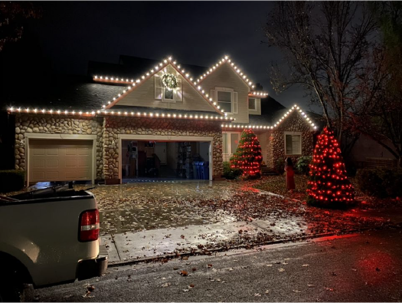The Quiet Engineering Behind Durable Holiday Lighting
Well-made holiday lighting looks effortless in December because the hard thinking happened long before a ladder went up. In our Boise-area installs, the designs that sail through cold snaps, wind, and wet weather have one thing in common: materials and connections specified as a system—from LED bulbs and wire insulation to sealed connectors and correctly sized power supplies.
Bulbs: light engines, not ornaments
Not all C7/C9 LED bulbs are alike. Lens resin, diode package (e.g., SMD packages), thermal path, and base fit determine brightness, color stability, and lifespan. Two practical rules drive longevity:
- Mechanical fit: A bulb base that seats firmly in the socket resists vibration, wind, and thermal cycling (fewer mid-season flickers).
- Thermal management: Efficient diode and lens design shed heat better, which protects color and lumen output over years.
We specify bulbs where the lens clarity, base tolerances, and diode package are designed as a family, so strings remain uniform from year one to year five. Reputable vendors—such as Village Lighting—publish bulb construction details (e.g., SMD diodes, impact-resistant lenses) that align with long-run durability. (See Village Lighting’s technical pages under Sources.)
Strands & wire: insulation and strain relief
String wire lives a hard life—flexing over clips and roof edges, expanding/contracting in freeze–thaw cycles. Two things matter most:
- Insulation/jacket quality and wall thickness to protect conductors at the bend points and terminations where failures start.
- Certification to the right standard. Seasonal sets are evaluated under UL 588 for temporary decorative use; UL 588 Supplement SD covers factory-assembled, parallel-connected strings intended for year-round use, adding heavier-duty requirements (e.g., hard-usage cord types, lamp-holder construction). If you want “permanent-style” seasonal strings to survive more than a few months, choose gear evaluated to the correct portion of the standard.
Bottom line: the standard your product is evaluated to predicts how it tolerates weather, flexing, and strain—and how many outages you’ll chase in December.
Connection points: keep water out, keep runs together
Most service calls start at a connection. We prefer threaded, sealed (O-ring) “coaxial” style connectors for long rooflines and trees. Compared with loose push-fits, a positive screw connection:
- resists wicking and wind-driven water,
- tolerates movement without backing off, and
- is faster to assemble consistently across a crew.
For any system, train for clean threads, intact O-rings, and strain relief at every join.
Power & layout: the quiet backbone
Good looks depend on good power. A simple design checklist prevents nuisance trips and dimming, especially as temperatures drop:
- Match adapter/output to run length and total load; stay within manufacturer’s max-run tables.
- Distribute loads across circuits; fuse where required.
- Build drip loops on vertical drops so water sheds before it reaches a connector or adapter.
- Use outdoor-rated, GFCI-protected receptacles and cords. (Current electrical codes require GFCI protection for outdoor outlets at dwellings; see Sources.)
- Keep components in the same product family (bulbs, wire, connectors, power) so tolerances match year after year.
Why we standardize on an industry leader
There are many capable manufacturers. We specify brands that publish construction details and test to the right standards because consistency across bulbs, wire, adapters, and connectors dramatically reduces callbacks. Village Lighting is one example of a supplier that builds for durability and maintains part-to-part fit across seasons.
The long view: quality in, quality out
You know quality is paying off when you see fewer mid-season visits, cleaner takedowns, and uniform color across the eaves five winters later. That’s why we guarantee the lighting equipment for as long as it remains in active service with us—because the materials and build choices support that promise.
Quick homeowner notes
- LED + controls save energy. DOE notes residential LEDs use at least 75% less energy and last up to 25× longer than incandescent; pair them with dusk-to-dawn photocells or timers so lights run only when needed.
- Work safely. Holiday decorating injuries are common; the CPSC reports ~14,900 ED visits in the 2022–23 season, with nearly half involving falls. Use proper ladders, GFCI-protected outdoor circuits, and keep lighting well clear of power lines.
Sources
- UL Solutions — String lights for all-year use (UL 588 Supplement SD): clarification of year-round string-light requirements.
- https://www.ul.com/thecodeauthority/news/string-lights-all-year-useul-588-supplement-sd UL Solutions
- UL Standards Shop — UL 588 scope: seasonal decorative products; temporary use ≤ 90 days; includes reference to Supplement SD for year-round strings.
- https://www.shopulstandards.com/ProductDetail.aspx?UniqueKey=30215 shopulstandards.com
- UL Solutions — Year-round compliance testing overview (context on why Supplement SD was added for continuous-use strings).
- https://www.ul.com/services/string-lights-year-round-compliance-testing-services UL Solutions
- Village Lighting (example vendor specs): SMD LED construction, impact-resistant lenses, product family consistency.
- https://villagelighting.com/products/c9-projector-series-smd-led | https://villagelighting.com/blogs/learn-about-our-products/guide-to-christmas-light-bulbs Village Lighting Company+1
- Christmas Designers (trade guidance) — benefits of threaded, O-ring “coaxial” connectors for weather-resistant assemblies.
- https://www.christmasdesigners.com/blog/coaxial-connect-christmas-lights-benefits/ | connector reference: https://www.christmasdesigners.com/x-coaxial-connector.html christmasdesigners.com+1
- U.S. DOE — LED Lighting (efficiency/longevity) and Lighting Controls (timers, photosensors).
- https://www.energy.gov/energysaver/led-lighting | https://www.energy.gov/energysaver/lighting-controls The Department of Energy's Energy.gov+1
- CPSC — Holiday Safety (injury statistics; ladder/electrical cautions).
- https://www.cpsc.gov/Safety-Education/Safety-Education-Centers/Holiday-Safety U.S. Consumer Product Safety Commission
- GFCI (NEC 2020 updates, outdoor outlets) — overview from Eaton and code education sources (outdoor outlets ≤50A require GFCI protection; check local adoption).
- https://www.eaton.com/content/dam/eaton/products/residential/electrical-safety/nec-code-210-8-gfci-protection-for-outdoor-outlets.pdf | https://www.electricallicenserenewal.com/Electrical-Continuing-Education-Courses/NEC-Content.php?sectionID=812 Eaton+1

